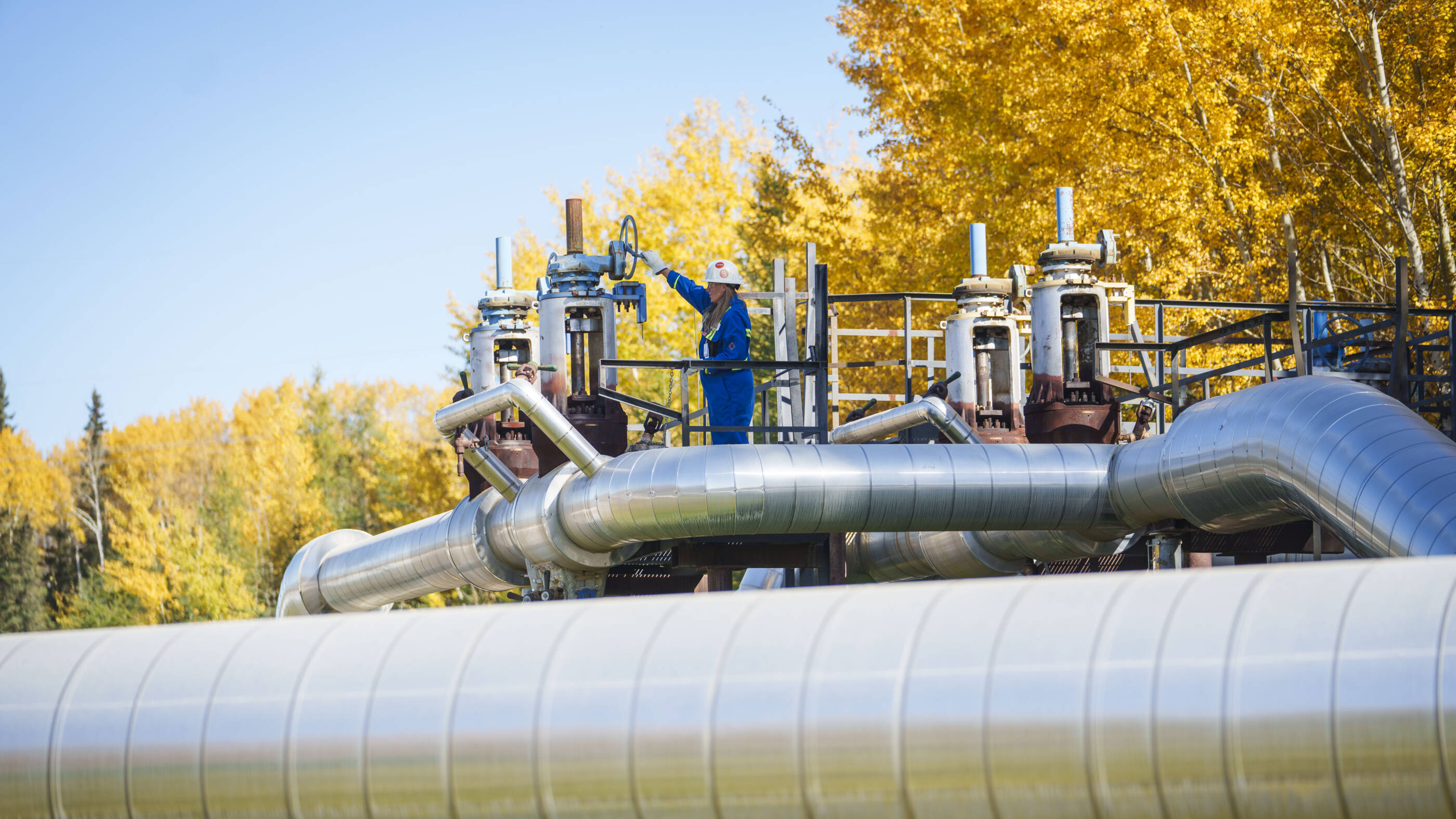5 min read
• April 30, 2025Sustainability Report Executive Summary
5 min read
• April 30, 2025Navigate to:
Our approach to sustainability
The world needs energy, more now than ever before.Today, billions of people cannot meet their most basic needs – like access to clean cooking fuel and electricity. At the same time, billions more need energy to sustain their quality of life and contribute to economic growth.
And as populations grow, people around the world will need more petrochemical products – critical in cars, homes, hospitals, kitchens – and anywhere people thrive.
We’re hard at work creating sustainable solutions that improve quality of life and meet society’s evolving needs.
Because we know it’s not just what we do that matters, but also how we do it.
Today
~4B
2050
>10B
people on the planet
Protect Tomorrow. Today. is the guiding principle behind our approach to sustainability.
It’s also a call to action. It drives us to look at our businesses with the mindset to be the most responsible operator in our industry.
It gives us a consistent focus on doing the right things, the right way, to the highest standards.
We encourage our leaders and teams to ask questions that go beyond “What are we required to do?” We are asking proactive questions like:
- How can we reduce or mitigate emissions, waste, or the resources we use in our operations?
- How can we increase benefits for our communities and reduce impacts?
- Are there opportunities to collaborate on industry standards and regulations?
The answers are as complex as our portfolio, and they will change over time. How we act on what we learn will ultimately help us capture the full value of our competitive advantages – in the right way.
What it takes to create sustainable solutions
Doing the right things the right way
Meeting society’s needs requires long-term focus and large-scale solutions. It also takes collaboration – with everyone our business reaches:
-
Communities
Be a trusted partner that creates high-quality jobs, operates safely with care for the environment, and invests to address socioeconomic challenges. -
Employees
Provide unrivalled opportunities for personal and professional growth, with safe, impactful work for an entire career. -
Customers
Meet their needs for affordable, reliable, and lower-emission energy and products. -
Investors
Deliver attractive returns on the capital entrusted to us – today, tomorrow, and into the future.
Putting our values to work
We hold our people to the highest ethical standards and expect them to do what’s right – across the company and throughout our sustainability focus areas.
Our Operations Integrity Management System (OIMS) shows our people how. It sets clear standards supported by processes that help us manage risks everywhere we work – from remote environments to vibrant communities.
ExxonMobil's Core Values

Pursuing environmental excellence
As a global company, our environmental story is as diverse and complex as the ~60 countries we live and work in around the world.
Our Advancing Climate Solutions report details our approach to reducing emissions. And that’s just part of the story.
We do far more every day to pursue environmental excellence:
-
Caring for land and biodiversity
Reducing potential impacts on ecosystems and protecting the value they provide to nature and people. -
Conserving water resources
Safeguarding water resources by prudently managing and monitoring our water use – with a focus on the quality and supply of freshwater. -
Improving air quality
Meeting or exceeding environmental regulatory requirements and working to reduce nitrogen oxides (NOx), sulfur oxides (SOx), and volatile organic compounds (VOCs). -
Minimizing operational waste
Incorporating best practices to manage and treat waste. We look for ways to avoid waste entirely or recover, recycle, and reuse it when possible.
How have we turned these four environmental focus areas into results? We have:
- Worked with Tandem Global (formerly Wildlife Habitat Council) on land and habitat conservation for > 30 years.
- Used recycled produced, brackish or reclaimed sources to supply 98% of the water in our Permian Basin hydraulic fracturing operations in 2024.2
- Reduced reportable emissions of NOx, SOx, and VOCs from 2016 to 2024 by ~25%.3
- Diverted from landfill >95% of waste produced in our global network of lubricants blending and packaging plants in 2023 and 2024.
Helping people thrive around the world
Everyone needs reliable energy – to heat their homes, cook their meals, and improve their quality of life.
That’s why we’re working to lead in an energy transition that will:
- Provide solutions that support people around the world.
- Lower greenhouse gas emissions.
- Manage potential impacts.
Supporting our workforce, respecting human rights, and driving local growth
We have a century-old legacy of growing local economies, supporting communities, developing our workforce, and maintaining a constant focus on keeping people safe. Our core values and We are ExxonMobil leadership culture have led the way.
Everyone at ExxonMobil plays a role
We expect our employees to be respectful and inclusive, to care for each other, and to contribute to the well-being of our communities and the environment. Our Investing in People report describes how we develop our workforce to make this happen.
We focus on personnel safety and are determined to to build a working environment where Nobody Gets Hurt.
Our Operations Integrity Management System helps our people do their part in process safety for the security and health of our employees, contractors, and others.

The numbers tell a powerful story:
Safety
- 0.02 industry-leading lost-time incident rate (LTIR) per 200,000 work hours in 2023 – maintained our 0.02 LTIR in 2024.4
- Zero high-consequence product stewardship-related incidents in our Fuels, Lubricants, and Chemicals businesses again in 2024.
Employees
- ~30-year average length of service for retiring employees.
- >12,000 internal job rotations per year in support of development plans.
- #1 most attractive U.S. energy company for engineering students for 12th consecutive year.5
- #1 energy company for engineering students in countries with large ExxonMobil footprint.5
Community
- $200 million in worldwide giving in 2024.6
- $1.6 billion contributed to education around the world from 2000 to 2024.7
- ~$39 million to STEM education in 2024 alone.7
Doing what’s right
Our core values don’t stop at our door. Our Standards of Business Conduct demonstrate our commitment to be a good neighbor in the places we operate around the world.
Respecting human rights is important to the well-being of our communities. It’s embedded into our policies, processes, and due diligence practices. We also provide access to remedy and channels for people to engage with us — in ways that make the most sense for the local culture.
Every community has a unique culture and history, and we believe everyone deserves to be treated fairly.
We work to promote inclusive sourcing open to all. We seek to work with qualified suppliers that share our commitment to respecting human rights and working to reduce impacts to the environment.
Here is a snapshot:
- ~$6.8B in annual spend with diverse suppliers in the United States8
- >$129M invested to help community-based and global partners implement programs that benefit women
Other ways we make an impact
Notably, we’re helping to meet the increasing demand for products that play critical roles in hygiene, food preservation, personal safety, transportation, and much more. And we’re working to expand the plastics life cycle through advanced recycling, allowing us to help address the global plastic waste challenge and make valuable products from discarded materials.
This is a glimpse into the meaningful work we do each day – from improving our communities to investing in energy solutions and people. Each of these plays an important role in the communities we serve around the world.
80M
1B
Publications
Explore more

Expanding the plastics life cycle
3 min read
• April 30, 2025
Integrating sustainability into what we do
5 min read
• April 30, 2025
Working with suppliers

Enhancing process safety
3 min read
• April 30, 2025
Improving air quality
2 min read
• April 30, 2025
FOOTNOTES:
- Using UN HDI data from 2022, we determined that about 4 billion people live below the “modern energy minimum.” That’s far below modern standards of living, which require reliable energy for housing, infrastructure, jobs, and mobility. See our 2024 Global Outlook.
- In 2024, we acquired Pioneer. In our combined Permian Basin operations, recycled produced water includes water from ExxonMobil and other oil & gas operators in the region. Reclaimed water includes treated municipal and industrial wastewater.
- Air emissions performance data includes recent acquisitions (Denbury data beginning November 2, 2023 and Pioneer data beginning May 3, 2024).
- ExxonMobil LTIR based on full-year performance data for 2023 and 2024 as of March 12, 2025. Incidents include injuries and illnesses. ExxonMobil workforce includes employees, contractors, and recent acquisitions (Denbury data beginning November 2, 2023, and Pioneer data beginning May 3, 2024). Industry benchmark: The International Association of Oil & Gas Producers (IOGP) safety performance indicators and the American Fuel & Petrochemical Manufacturers (AFPM) Report of Occupational Injuries and Illnesses are the Upstream and Downstream industry benchmarks, respectively. IOGP safety performance indicators data converted from incidents per 1 million work hours to incidents per 200,000 work hours. ExxonMobil analysis of data published by AFPM and IOGP. 2024 industry data not available at time of publication. Performance data may include rounding.
- Universum data (www.universumglobal.com).
- Includes donations from Exxon Mobil Corporation, its divisions and affiliates, the ExxonMobil Foundation, as well as employee and retiree giving through the ExxonMobil’s matching gift and volunteer programs.
- Includes donations from ExxonMobil and the ExxonMobil Foundation.
- Includes direct ExxonMobil spending on Tier 1 suppliers and a select group of Tier 2 suppliers, which includes small business owned, veteran business owned, and other classifications informed by industry reporting guidance. At all times decisions are made based on the best supplier for the need. 2024 data from Pioneer operations not available at time of publication.
FORWARD-LOOKING STATEMENT WARNING
Images or statements of future ambitions, aims, aspirations, plans, goals, events, projects, projections, opportunities, expectations, performance, or conditions in the publications, including plans to reduce, abate, avoid or enable avoidance of emissions or reduce emissions intensity, sensitivity analyses, expectations, estimates, the development of future technologies, business plans, and sustainability efforts are dependent on future market factors, such as customer demand, continued technological progress, stable policy support and timely rule-making or continuation of government incentives and funding, and represent forward-looking statements. Similarly, emission-reduction roadmaps to drive toward net zero and similar roadmaps for emerging technologies and markets, and water management roadmaps to reduce freshwater intake and/or manage disposal, are forward-looking statements. These statements are not guarantees of future corporate, market or industry performance or outcomes for ExxonMobil or society and are subject to numerous risks and uncertainties, many of which are beyond our control or are even unknown.
Actual future results, including the achievement of ambitions to reach Scope 1 and 2 net zero from operated assets by 2050, to reach Scope 1 and 2 net zero in heritage Permian Basin unconventional operated assets by 2030, and in Pioneer Permian assets by 2035, to eliminate routine flaring in-line with World Bank Zero Routine Flaring, to reach near zero methane emissions from operated assets and other methane initiatives to meet ExxonMobil’s greenhouse gas emission reduction plans and goals, divestment and start-up plans, and associated project plans as well as technology advances, including in the timing and outcome of projects to capture, transport and store CO2, produce hydrogen and ammonia, produce lower-emission fuels, produce ProxximaTM systems, produce carbon materials, produce lithium, and use plastic waste as feedstock for advanced recycling; future debt levels and credit ratings; business and project plans, timing, costs, capacities and profitability; resource recoveries and production rates; planned Denbury and Pioneer integrated benefits; obtain data on detection, measurement and quantification of emissions including reporting of that data or updates to previous estimates and progress in sustainability focus areas could vary depending on a number of factors, including global or regional changes in oil, gas, petrochemicals, or feedstock prices, differentials, seasonal fluctuations, or other market or economic conditions affecting the oil, gas, and petrochemical industries and the demand for our products; new market products and services; future cash flows; our ability to execute operational objectives on a timely and successful basis; the ability to realize efficiencies within and across our business lines; new or changing government policies for lower carbon and new market investment opportunities, or policies limiting the attractiveness of investments such as European taxes on energy and unequal support for different methods of carbon capture; developments or changes in local, national, or international treaties, laws, regulations, taxes, trade sanctions, trade tariffs, and incentives affecting our business, including those related to greenhouse gas emissions, plastics, carbon storage and carbon costs; timely granting of governmental permits and certifications; uncertain impacts of deregulation on the legal and regulatory environment; evolving reporting standards for these topics and evolving measurement standards for reported data; trade patterns and the development and enforcement of local, national and regional mandates; unforeseen technical or operational difficulties; the outcome of research efforts and future technology developments, including the ability to scale projects and technologies such as electrification of operations, advanced recycling, carbon capture and storage, hydrogen and ammonia production, ProxximaTM systems, carbon materials or direct lithium extraction on a commercially competitive basis; the development and competitiveness of alternative energy and emission reduction technologies; unforeseen technical or operating difficulties, including the need for unplanned maintenance; availability of feedstocks for lower-emission fuels, hydrogen, or advanced recycling; changes in the relative energy mix across activities and geographies; the actions of co-venturers competitors; changes in regional and global economic growth rates and consumer preferences including willingness and ability to pay for reduced emissions products; actions taken by governments and consumers resulting from a pandemic; changes in population growth, economic development or migration patterns; timely completion of construction projects; war, civil unrest, attacks against the Company or industry, and other political or security disturbances, including disruption of land or sea transportation routes; decoupling of economies, realignment of global trade and supply chain networks, and disruptions in military alliances; and other factors discussed here and in Item 1A. Risk Factors of our Annual Report on Form 10-K and under the heading “Factors affecting future results” available under the “Earnings” tab through the “Investors” page of our website at www.exxonmobil.com. The Advancing Climate Solutions Report includes 2024 greenhouse gas emissions performance data as of March 1, 2025, and Scope 3 Category 11 estimates for full year 2024 as of February 19, 2025. The greenhouse gas intensity and greenhouse gas emission estimates include Scope 2 market-based emissions. The Sustainability Report, the Advancing Climate Solutions Report, and corresponding Executive Summaries were issued on April 30, 2025. The content and data referenced in these publications focus primarily on our operations from Jan. 1, 2024 – Dec. 31, 2024, unless otherwise indicated. Tables on our “Metrics and data” page were updated to reflect full year 2024 data. Information regarding some known events or activities in 2025 and historical initiatives from prior years are also included. No party should place undue reliance on these forward-looking statements, which speak only as of the dates of these publications. All forward-looking statements are based on management’s knowledge and reasonable expectations at the time of publication. ExxonMobil assumes no duty to update these statements or materials as of any future date, and neither future distribution of this material nor the continued availability of this material in archive form on our website should be deemed to constitute an update or re-affirmation of these figures or statements as of any future date. Any future update will be provided only through a public disclosure indicating that fact.
See “ABOUT THE ADVANCING CLIMATE SOLUTIONS AND SUSTAINABILITY REPORTS” at the end of this document for additional information on these reports and the use of non-GAAP and other financial measures.
ABOUT THE ADVANCING CLIMATE SOLUTIONS AND SUSTAINABILITY REPORTS
The Advancing Climate Solutions Report contains terms used by the TCFD, as well as information about how the disclosures in this report are consistent with the recommendations of the TCFD. In doing so, ExxonMobil is not obligating itself to use any terms in the way defined by the TCFD or any other party, nor is it obligating itself to comply with any specific recommendation of the TCFD or to provide any specific disclosure. For example, with respect to the term “material,” individual companies are best suited to determine what information is material, under the long-standing U.S. Supreme Court definition, and whether to include this information in U.S. Securities and Exchange Act filings. In addition, the ISSB is evaluating standards that provide their interpretation of TCFD which may or may not be consistent with the current TCFD recommendations. The Sustainability Report and Advancing Climate Solutions Report are each a voluntary disclosure and are not designed to fulfill any U.S., foreign, or third-party required reporting framework.
Forward-looking and other statements regarding environmental and other sustainability efforts and aspirations are not intended to communicate any material investment information under the laws of the United States or represent that these are required disclosures. These publications are not intended to imply that ExxonMobil has access to any significant non-public insights on future events that the reader could not independently research. In addition, historical, current, and forward-looking environmental and other sustainability-related statements may be based on standards for measuring progress that are still developing, internal controls and processes that continue to evolve, and assumptions that are subject to change in the future, including future laws and rulemaking. Forward-looking and other statements regarding environmental and other sustainability efforts and aspirations are for informational purposes only and are not intended as an advertisement for ExxonMobil’s equity, debt, businesses, products, or services and the reader is specifically notified that any investor-requested disclosure or future required disclosure is not and should not be construed as an inducement for the reader to purchase any product or services. The statements and analysis in these publications represent a good faith effort by the Company to address these investor requests despite significant unknown variables and, at times, inconsistent market data, government policy signals, and calculation, methodologies, or reporting standards.
Actions needed to advance ExxonMobil’s 2030 greenhouse gas emission-reductions plans are incorporated into its medium-term business plans, which are updated annually. The reference case for planning beyond 2030 is based on the Company’s Global Outlook research and publication. The Global Outlook is reflective of the existing global policy environment and an assumption of increasing policy stringency and technology improvement to 2050. However, the Global Outlook does not attempt to project the degree of required future policy and technology advancement and deployment for the world, or ExxonMobil, to meet net zero by 2050. As future policies and technology advancements emerge, they will be incorporated into the GIobal Outlook, and the Company’s business plans will be updated as appropriate. References to projects or opportunities may not reflect investment decisions made by the corporation or its affiliates. Individual projects or opportunities may advance based on a number of factors, including availability of stable and supportive policy, permitting, technological advancement for cost-effective abatement, insights from the Company planning process, and alignment with our partners and other stakeholders. Capital investment guidance in lower-emission and other new investments is based on our corporate plan; however, actual investment levels will be subject to the availability of the opportunity set, stable public policy support, other factors, and focused on returns.
Energy demand modeling aims to replicate system dynamics of the global energy system, requiring simplifications. The reference to any scenario or any pathway for an energy transition, including any potential net-zero scenario, does not imply ExxonMobil views any particular scenario as likely to occur. In addition, energy demand scenarios require assumptions on a variety of parameters. As such, the outcome of any given scenario using an energy demand model comes with a high degree of uncertainty. For example, the IEA describes its NZE scenario as extremely challenging, requiring unprecedented innovation, unprecedented international cooperation, and sustained support and participation from consumers, with steeper reductions required each year since the scenario’s initial release. Third-party scenarios discussed in these reports reflect the modeling assumptions and outputs of their respective authors, not ExxonMobil, and their use or inclusion herein is not an endorsement by ExxonMobil of their underlying assumptions, likelihood, or probability. Investment decisions are made on the basis of ExxonMobil’s separate planning process but may be secondarily tested for robustness or resiliency against different assumptions, including against various scenarios. These reports contain information from third parties. ExxonMobil makes no representation or warranty as to the third-party information. Where necessary, ExxonMobil received permission to cite third-party sources, but the information and data remain under the control and direction of the third parties. ExxonMobil has also provided links in this report to third-party websites for ease of reference. ExxonMobil’s use of the third-party content is not an endorsement or adoption of such information.
ExxonMobil reported emissions, including reductions and avoidance performance data, are based on a combination of measured and estimated data. We assess our performance to support continuous improvement throughout the organization using our Environmental Performance Indicator (EPI) manual. The reporting guidelines and indicators in the Ipieca, the American Petroleum Institute (API), the International Association of Oil and Gas Producers Sustainability Reporting Guidance for the Oil and Gas Industry (4th edition, 2020, revised February 2023) and key chapters of the GHG Protocol inform the EPI and the selection of the data reported. Emissions reported are estimates only, and performance data depends on variations in processes and operations, the availability of sufficient data, the quality of those data and methodology used for measurement and estimation. Emissions data is subject to change as methods, data quality, and technology improvements occur, and changes to performance data may be updated. Emissions, reductions, abatements and enabled avoidance estimates for non-ExxonMobil operated facilities are included in the equity data and similarly may be updated as changes in the performance data are reported. ExxonMobil’s plans to reduce emissions are good-faith efforts based on current relevant data and methodology, which could be changed or refined. ExxonMobil works to continuously improve its approach to estimate, detect, measure, and address emissions. ExxonMobil actively engages with industry, including API and Ipieca, to improve emission factors and methodologies, including measurements and estimates.
Any reference to ExxonMobil’s support of, work with, or collaboration with a third-party organization within these publications do not constitute or imply an endorsement by ExxonMobil of any or all of the positions or activities of such organization. ExxonMobil participates, along with other companies, institutes, universities and other organizations, in various initiatives, campaigns, projects, groups, trade organizations, and other collaborations among industry and through organizations like the United Nations that express various ambitions, aspirations and goals related to climate change, emissions, sustainability, and the energy transition. ExxonMobil’s participation or membership in such collaborations is not a promise or guarantee that ExxonMobil’s individual ambitions, future performance or policies will align with the collective ambitions of the organizations or the individual ambitions of other participants, all of which are subject to a variety of uncertainties and other factors, many of which may be beyond ExxonMobil’s control, including government regulation, availability and cost-effectiveness of technologies, and market forces and other risks and uncertainties. Such third parties’ statements of collaborative or individual ambitions and goals frequently diverge from ExxonMobil’s own ambitions, plans, goals, and commitments. ExxonMobil will continue to make independent decisions regarding the operation of its business, including its climate-related and sustainability-related ambitions, plans, goals, commitments, and investments. ExxonMobil’s future ambitions, goals and commitments reflect ExxonMobil’s current plans, and ExxonMobil may unilaterally change them for various reasons, including adoption of new reporting standards or practices, market conditions; changes in its portfolio; and financial, operational, regulatory, reputational, legal and other factors.
References to “resources,” “resource base,” “recoverable resources” and similar terms refer to the total remaining estimated quantities of oil and natural gas that are expected to be ultimately recoverable. The resource base includes quantities of oil and natural gas classified as proved reserves, as well as quantities that are not yet classified as proved reserves, but that are expected to be ultimately recoverable. The term “resource base” is not intended to correspond to SEC definitions such as “probable” or “possible” reserves. For additional information, see the “Frequently Used Terms” on the Investors page of the Company’s website at www.exxonmobil.com under the header “Modeling Toolkit.” References to “oil” and “gas” include crude, natural gas liquids, bitumen, synthetic oil, and natural gas. The term “project” as used in these publications can refer to a variety of different activities and does not necessarily have the same meaning as in any government payment transparency reports.
Exxon Mobil Corporation has numerous affiliates, many with names that include ExxonMobil, Exxon, Mobil, Esso, and XTO. For convenience and simplicity, those terms and terms such as “Corporation,” “company,” “our,” “we,” and “its” are sometimes used as abbreviated references to one or more specific affiliates or affiliate groups. Abbreviated references describing global or regional operational organizations, and global or regional business lines are also sometimes used for convenience and simplicity. Nothing contained herein is intended to override the corporate separateness of affiliated companies. Exxon Mobil Corporation’s goals do not guarantee any action or future performance by its affiliates or Exxon Mobil Corporation’s responsibility for those affiliates’ actions and future performance, each affiliate of which manages its own affairs. For convenience and simplicity, words like venture, joint venture, partnership, co-venturer and partner are used to indicate business relationships involving common activities and interests, and those words may not indicate precise legal relationships. These publications cover Exxon Mobil Corporation’s owned and operated businesses and do not address the performance or operations of our suppliers, contractors or partners unless otherwise noted. In the case of certain joint ventures for which ExxonMobil is the operator, we often exercise influence but not control. Thus, the governance, processes, management and strategy of these joint ventures may differ from those in these reports. At the time of publication, ExxonMobil has completed the acquisitions of Denbury Inc. and Pioneer Natural Resources Company. These reports and the data therein do not speak of these companies’ pre-acquisition governance, risk management, strategy approaches, or emissions or sustainability performance unless specifically referenced.
These reports or any material therein are not to be used or reproduced without the permission of Exxon Mobil Corporation. All rights reserved.
SUPPLEMENTAL INFORMATION FOR NON-GAAP AND OTHER MEASURES
The Positioned for Growth in a Lower-Emission Future section of the Advancing Climate Solutions Report mentions modeled operating cash flow in comparing different businesses over time in a future scenario. Historic operating cash flow is defined as net income, plus depreciation, depletion and amortization for consolidated and equity companies, plus noncash adjustments related to asset retirement obligations plus proceeds from asset sales. The Company’s long-term portfolio modeling estimates operating cash flow as revenue or margins less cash expenses, taxes and abandonment expenditures plus proceeds from asset sales before portfolio capital expenditures. The Company believes this measure can be helpful in assessing the resiliency of the business to generate cash from different potential future markets. The performance data presented in the Advancing Climate Solutions Report and Sustainability Report, including on emissions, is not financial data and is not GAAP data.


